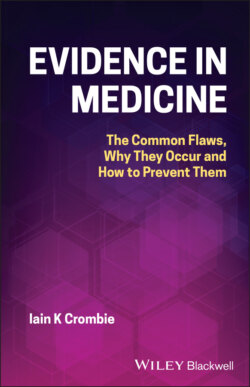Читать книгу Evidence in Medicine - Iain K. Crombie - Страница 10
COMPARING GROUPS
ОглавлениеCase series can provide support for a treatment if, as with insulin, the benefits are immediate and substantial. But observations on a set of patients are often not sufficient to identify whether a treatment is truly effective. Consider the management of gunshot wounds in the sixteenth century. At that time it was believed that the bullet introduced poison into the body, and that cauterising the wound with boiling oil mixed with treacle would detoxify it [20, 21]. The treatment was very unpleasant, but was thought to save lives. Force of circumstances led the French barber‐surgeon, Ambroise Paré, to use a different treatment. During the Italian war of 1536–1538, Paré ran out of oil and instead used a balm of egg yolk, rose oil and turpentine [20]. He observed that the outcomes differed substantially between the two groups: those treated with the hot oil were feverish and in ‘great pain and swelling about the edges of their wounds’, whereas those given the balm were resting comfortably [21]. Further trials of the balm convinced Paré that gunshot wounds were not poisoned and should not be cauterised [20].
The comparison of groups also helped promote a technique for the prevention of smallpox. In the 1700s smallpox was a leading cause of death, with many of those who survived suffering disfigurement and blindness [22]. The available preventive measure was to infect children with puss or scab material from smallpox victims, a process known as variolation. Despite reports that it was beneficial [23], there was widespread concern that variolation might carry a greater risk of dying than allowing people to contract the disease naturally. James Jurin evaluated this in the 1720s, by collecting data on death rates in three groups: those who were diagnosed with smallpox, those at risk of contracting smallpox and those who had been variolated [22, 23]. The results appeared convincing with death rates of 16.5% (diagnosed cases), 8.3% (at risk) and 2.0% (variolated) [23]. Preventing smallpox was a much safer practice than letting nature take its course.
Death following childbirth was a serious concern in the seventeenth to nineteenth centuries, causing epidemics ‘of unimaginable proportions’ [24]. A major cause of this mortality, puerperal fever (fever following childbirth), was investigated by Ignaz Semmelweis, a Hungarian doctor. In 1844 he compared the death rates among patients in two wards of a hospital in Vienna. He found that the death rates in a ward staffed by doctors was much higher (16%) than in the one run by midwives (2%) [25]. This, and other observations, led Semmelweis to conclude that the illness was transmitted by doctors coming directly from a post‐mortem to help deliver a baby. He initiated a preventive measure, compulsory hand washing in a chloride of lime solution, which reduced the mortality in the doctors’ ward to 3% [25]. His approach was not popular, because it implied that doctors transmitted disease, and Semmelweis's contract was not renewed. He was finally vindicated some 30 years later when Pasteur identified the bacterium, Streptococcus pyogenes, that caused puerperal fever [25].
These treatment evaluations utilised two different types of comparisons: contemporary controls and historical controls. Contemporary controls are patients who were seen at the same time as those getting the new treatment, but who received the conventional care. Historical controls are patients who had been treated previously in the same location (e.g. hospital). Jurin's comparisons of groups at risk of smallpox, and Semmelweis's comparison of puerperal fever in two wards, used contemporary controls. In contrast the comparison of puerperal fever before and after introducing handwashing, and Paré's comparison of treatments for gunshot wounds, used historical control groups.
The problem with both types of control groups is that there could be systematic differences between the patients in the different groups. Isaac Massey, a contemporary of Jurin, made this criticism of the work on smallpox, pointing out that those who could afford variolation may have been in better health than those in the comparison groups [22]. He concluded that what was needed was groups that were similar, they ‘must and ought to be as near as may be on a Par’ [22].
